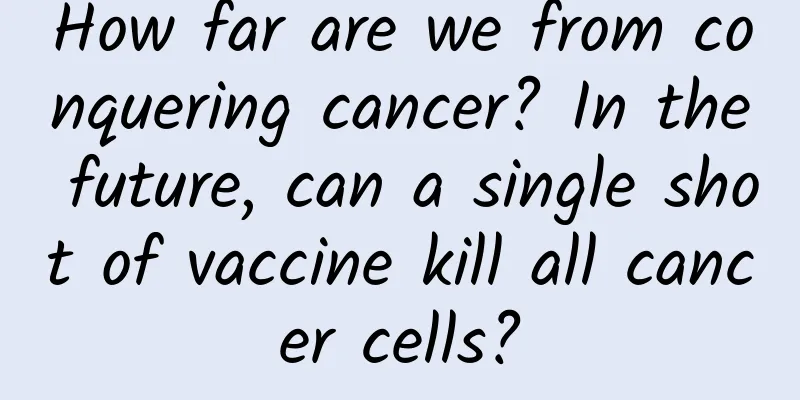How far are we from conquering cancer? In the future, can a single shot of vaccine kill all cancer cells?

|
Recently, people have been asking: A single injection of cancer vaccine can kill all cancer cells in a person. How far is this ideal from being realized? There is a saying that goes "Ideals are rich, but reality is harsh", and this question can be answered in the same way. The idea that a single shot of vaccine can kill all cancer cells in the body is still a fantasy, and it will never be realized in the future. To know why, just be patient and read the answer below. Space-Time Communication will help you unravel the mystery. First, we need to understand what cancer cells are. The human body is composed of a large number of somatic cells, with 40 to 60 trillion cells in one human body. The normal metabolism of these cells maintains the health of the human body. In human genetic genes, there are proto-oncogenes and tumor suppressor genes, which dominate the normal metabolism of human cells. Proto-oncogenes are responsible for cell division and proliferation cycles, which are indispensable for human growth; tumor suppressor genes can prevent and inhibit abnormal cell proliferation and ensure the normal growth of the body. Each cell divides 50 to 60 times in a person's lifetime, and the total number of cell divisions in the body is as many as 10^16 times. During these divisions, some cells will mutate, and the probability of each cell mutating is 10^-6 times. In this way, the probability of overall cell mutation in a person's lifetime is 10^10 times, which is as many as 1 billion times. Cancer cells are mutated cells that divide rapidly and theoretically have unlimited proliferation capacity. If a person's cells mutate 1 billion times in his lifetime, doesn't that mean there is a 1 billion chance of getting cancer? In fact, this is not the case. Although there are many mutated cells in the normal division process of human cells, it is difficult for them to transform into cancer cells. Because cancer cells are not formed by a single cell mutation, studies have shown that this random mutation requires at least 3 to 7 times before it turns into cancer cells. Most cell mutations do not last long enough for the cancer cells to die. Even if some cancer cells are formed, they will be attacked by a large number of white blood cells after entering the blood. Only cancer cells that successfully escape will have the opportunity to grow and develop themselves. In order for cancer cells to form pathogenic factors, they must grow to more than 1 billion before they can be sensed by the human body. Cancer cells proliferate dozens of times faster than normal cells. The average human cell division cycle is about 2.5 years, while the cancer cell division cycle is 30 to 40 days. Normal cells can only divide 50 to 60 times in a lifetime, but cancer cells can proliferate indefinitely, and are known as immortal cells. These cells proliferate in large numbers in various organs of the human body, occupying the territory of normal cells, causing normal cell death, tissue damage, and transfer to the whole body through blood vessels and other channels. When cancer patients' body tissues undergo large-scale necrosis and bleeding, lose normal functions, and become infected with complications, their ultimate fate is death from organ failure. If a person has a genetic defect, a mutated oncogene, or a damaged tumor suppressor gene; or is exposed to various physical, chemical, or biological viruses, such as pollution, radiation, viruses, or frequent consumption of carcinogenic foods, which lead to uncontrolled cell mutations, the risk of cancer will be greatly increased. As the body's resistance is reduced in the elderly, normal cell metabolism will be disrupted, and the risk of cancer will increase. The earlier the cancer is discovered, the better, because cancer cells increase in multiples, 1 to 2, 2 to 4. Early detection means fewer cancer cells and slower proliferation, making it easier to treat. In the later stage, there are more cancer cells and the proliferation rate will increase faster and faster, making it more difficult to treat. A simple calculation will show that when the human body reaches 1 billion cells, it is difficult to detect. After 30 to 40 days, it will double, and in one year it will double tenfold. When the number of cancer cells reaches 1 trillion, cancer cells are already 1/40 to 60 of healthy cells. Is there any place for normal cells to survive in the primary organ? Is there still life? It can be seen that, generally speaking, if patients who are diagnosed with cancer do not receive treatment, their survival period will not exceed one year. What types of cancer vaccines are there? There are many types of cancer vaccines, mainly those that target cancer-causing viruses and those that utilize tumor cell antigens. The most successful vaccine now is the HPV vaccine, which is the only anti-cancer vaccine approved by the FDA (U.S. Food and Drug Administration). This vaccine mainly prevents cervical cancer and is now used in more than 100 countries, greatly reducing the risk of cervical cancer in women. HPV is called human papillomavirus in Chinese, and it is a member of the papillomavirus family. Studies have found that 99.7% of cervical cancer is caused by infection with HPV, so preventing HPV infection can greatly reduce the risk of cervical cancer. However, this vaccine is not 100% effective in preventing cervical cancer, because there are more than 100 types of HPV, 14 of which are high-risk and can cause almost all cervical cancers; the two highest-risk types, namely HPV-16 and HPV-18, can cause about 70% of cervical cancer cases. The vaccines currently on the market include bivalent vaccines, quadrivalent vaccines, and nonavalent vaccines. The so-called "several valents" refers to the prevention of several types of HPV. The bivalent vaccine prevents HPV-16 and HPV-18 viruses. Therefore, the preventive effects of these vaccines are different. China has approved the marketing of its own bivalent vaccine in 2020, and approved the marketing of GlaxoSmithKline's bivalent vaccine in 2016. The U.S. quadrivalent vaccine is still in phase III clinical trials and will probably be available in 2 to 3 years. The most important thing for a vaccine to treat cancer is to discover and confirm the relevant antigens of tumor cells, extract these antigens, and implant them into the human body to stimulate the internal immune system to release antibodies such as T cells, thereby achieving the goal of destroying cancer cells through the body's own immune system. However, although there has been progress in the research of this type of vaccine so far, only a very small number of vaccines have been launched on the market, and the effect is not obvious. This is because there are many types of human cancers, and there are hundreds of different antigens. In clinical trials, many cancer patients are exposed to multiple antigens, which can only stimulate a weak immune system response. Moreover, many antigens can be strongly expressed on tumor tissues and normal cells, so the immune system will mistakenly think that this is a normal phenomenon and it is difficult to stimulate a response. In order to stimulate more immune system responses, not only suitable antigens are needed, but also the coordination of multiple stimulation signals, which greatly increases the difficulty of research and development. In theory, all cancers can be effectively treated with this method, but it is not easy to screen out targeted new antigens from hundreds of antigens and to mobilize the body's immune system to the maximum extent through other stimulation methods. Long-term practice has shown that only with good luck can one or two mutant tumor-specific antigens be found, but these antigens are usually only effective for less than 5% of a certain type of tumor, and the effect is difficult to determine. This may be the reason why it is difficult for the FDA to approve such drugs for marketing. The FDA has always been considered the most stringent drug review agency in the world. So far, except for the HPV vaccine, the FDA has not approved any other anti-cancer vaccine for marketing. Only five vaccines have been approved by Russia, Canada, Europe, South Korea, and Brazil. For example, the Oncophage vaccine developed by the US startup Antigenics has been approved for marketing in Russia, and clinical trials have shown that it can reduce the time for cancer recurrence by up to two years. However, these data did not convince the FDA, which required Antigenics to conduct another clinical trial, which will take 8 to 10 years to complete and require an investment of at least $500 million. Hundreds of anti-cancer vaccines or new drugs are facing the same dilemma as Antigenics, and are at a standstill because they cannot afford such a cost. Currently, there are 18 new anti-cancer drugs approved by the FDA, which is said to account for only 8% of the new drugs under development, while the other 92% of hundreds of new drugs are unlikely to enter the market in the future. Although the FDA's management system can maximize the safety of drugs, some overly conservative practices are still questioned by some industry experts, and calls for its reform continue. In short, there is still a long way to go to rely on vaccines to prevent and treat the increasingly common cancers. But it is undeniable that new anti-cancer drugs and methods have made gratifying progress in recent years. Vaccines are certainly a future development direction for cancer treatment, but in addition to this, a number of new anti-cancer drugs and new medical methods have continued to emerge in recent years, which have given cancer patients more hope and effectively improved their survival time and quality of life. Some cancers that were once fatal have shown a trend of transforming into chronic diseases. Targeted drugs are the most important cancer treatment drugs in recent years. In fact, cancer cells are not difficult to kill. The problem is that while killing cancer cells, healthy cells will be damaged. These cancer cells use healthy cells as a shield, making it difficult for drugs or treatments to work. Traditional radiotherapy and chemotherapy have greatly reduced their therapeutic effects due to this problem. Targeted drugs are therapeutic drugs designed at the cellular and molecular level for identified carcinogenic sites. This site can be precisely a specific protein molecule inside a tumor cell, or a gene fragment. Based on this site, the drug can bind to the specific carcinogenic site after entering the human body, causing the tumor cell to die specifically without affecting the normal tissue cells around the tumor. This type of molecular targeted therapy drug is also called a "biological missile." This treatment method solves the problem of "killing one thousand enemies and injuring eight hundred of your own" in the past radiotherapy and chemotherapy, and also solves the dilemma that traditional methods are helpless and have no solution for patients with advanced cancer with widespread metastasis. I have a relative who was suddenly diagnosed with lung cancer, and it was in the late stage with widespread metastasis, and he could not have surgery. The doctor determined that he had only three months to live, and asked his family to give up treatment and spend the last days eating and having fun. Later, a turn for the better came. After genetic testing, it was found that there were target sites, so targeted drugs were used for treatment. Now three years have passed, and except for taking medicine on time and regular check-ups, he is basically the same as a normal person, and all indicators have returned to normal values, and his quality of life has not been affected at all. Of course, targeted drugs are not effective for all cancers, and there must be a specific site. At the same time, cancer cells are very cunning. In order to cope with the effects of drugs, they will continue to mutate, and thus targeted drugs will develop drug resistance. Therefore, new drugs need to be replaced every one or two years. Targeted drugs also have side effects, such as some that can cause elevated transaminases. But this is already many times stronger than conventional surgery, radiotherapy and chemotherapy in the past. The world's leading non-invasive stereotactic radiation technology is much better than conventional surgery and radiotherapy in the past. This method can very accurately focus radiation on cancerous lesions, killing only cancer cells without harming normal tissue cells. It reduces the damage to surrounding tissues caused by slight shaking during manual surgery by more than 10 times, avoids the damage to surrounding tissues caused by ordinary radiotherapy, and can also prevent implantation and blood metastasis caused by slight detachment of tumor tissue during surgery, reducing the risk of surgical complications. In addition, there are also therapies such as gene therapy, starvation therapy, immunotherapy, and cancer cell suicide. These studies are constantly making new progress. Therefore, it can be foreseen that humans will eventually overcome the threat of cancer and eliminate it from incurable diseases. Of course, in the prevention and treatment of cancer, we must follow scientific methods, go to regular hospitals and listen to the doctor's advice, do not believe in some quacks, rumors spread in society and on the Internet, and abuse some drugs and methods that have not been scientifically tested and approved by the management department, otherwise it will lead to serious consequences. For example, some people have heard of starvation therapy and think that as long as they eat less food and nutrition, they will starve to death cancer cells. In fact, this will make cancer cells grow more wildly, robbing the nutrition of healthy cells, and eventually the cancer cells will live well, but they will starve to death. The real starvation therapy is to cut off the blood supply to cancer cells through medical means and drugs, causing the cancer cells to die and the lesions to be eliminated. That’s all. If you like my article, please like and follow me. Thank you for reading and welcome to discuss. The copyright of Space-Time Communication is original. Infringement and plagiarism are unethical behavior. Please understand and cooperate. |
<<: What should not be eaten with melon? (Eating with crabs will cause poisoning)
Recommend
Vulvar itching caused by using sanitary pads
In life, there is no big problem for healthy wome...
The hotter the foot bath water, the better? The truth is——
Review expert: Wang Xuejiang, professor of pathop...
What is the reason for girls' premature graying of hair?
Now we see that the younger generation already ha...
A pimple on the breast skin
Female breasts are important to people's figu...
Why does menstrual blood turn black after moxibustion?
After moxibustion, dark menstruation is a normal ...
Dark area around genitals
The genitals are a very important part for women,...
Causes of abdominal bloating during pregnancy
Many pregnant women hope to give birth to a healt...
What is the cause of brown discharge in leucorrhea?
If a woman has abnormal leucorrhea, she should ha...
What are the harms of abortion?
As we all know, having a miscarriage is more or l...
Blocking antibodies to stop the fetus at a few weeks of pregnancy
In our lives, many pregnant women have habitual m...
What is the reason for yellow watery vaginal discharge?
Women's leucorrhea is a normal physiological ...
Be careful if you have polyps in these places! This type of polyp is almost 100% likely to turn into cancer.
One of the most confusing words on a physical exa...
Pharmacist’s Antidote | “Worried” Parents ~ Don’t worry about children being infected with Helicobacter pylori. Understanding these issues will help you become a worry-free parent!
Helicobacter pylori (Hp) is a spiral-shaped bacil...
How to perform abortion during cesarean section pregnancy
Caesarean section is very harmful to women's ...









